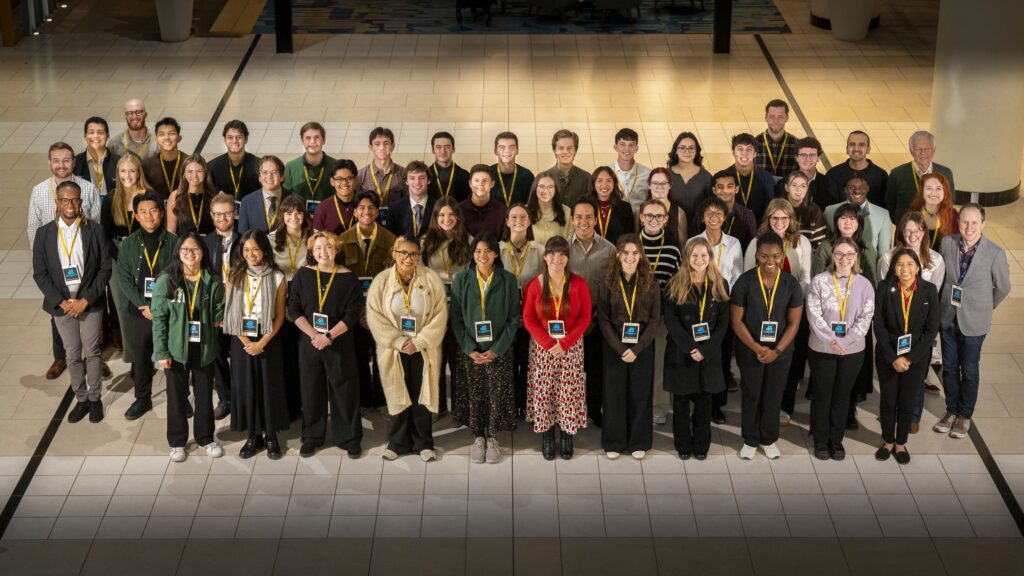In August of 1980, the Drum Corps International World Championships returned for the second year to Legion Field in Birmingham, Alabama. Blue Devils won, but three corps were close behind—the second-place 27th Lancers by 0.35 points, the third-place Bridgemen by 0.55 points, and the fourth-place Spirit of Atlanta by just 0.80 points.
For the first time in DCI’s history, all finalist corps had previously appeared in the Finals. Santa Clara Vanguard introduced asymmetrical drill formations, but for the first time fell out of the top-three corps, and the Blue Stars slipped into 13th place, not to appear as a World Class finalist for another 28 years.
During the 1980 Prelims competition, corps fans snuck to the backfield upper deck and created shout-outs to their favorite corps by flipping up certain chair bottoms. Then a group went backfield and spelled out “Jim Ott,” honoring the famed Blue Devils and Spirit of Atlanta brass arranger and instructor who tragically lost his life earlier in the season. That tribute remained untouched through the rest of Prelims and was still there after the fans left the stadium upon the conclusion of the Finals.
The Bridgemen took the field in 1980 playing the University of Alabama fight song for their on-field warm-up. However, few fans heard the song as they were cheering loudly when the corps was announced.
The corps’ opener was Julius Fučík’s “Thunder and Blazes,” the 1897 march written by “The Bohemian Sousa” that has become widely associated with circus bands. With trademark Bridgemen zaniness, the show started with the corps’ mascot chicken up front, appearing to blow the four counts of the show-starting whistle.
Eight costumed clowns were then introduced, as were three dancing circus bears, three dancing circus lions, and the trainers for each of those two groups. In addition, the center of each of the triple tenor drums looked like animals, flashing vicious teeth around the arced opening of the drum shells.
Bridgemen was perhaps the only corps that could have pulled off this sort of shtick, and the audience members ate it up.
“Pursuit of the Lady” served as the corps’ percussion feature, composed by electronic keyboard pioneer Joe Zawinul of “Birdland” fame. The work, originally titled, “The Pursuit of the Lady in the Feathered Hat,” was written for the jazz-fusion band Weather Report, which Zawinul co-founded.
The quirky piece allowed for some classic Bridgemen maneuvers, such as the color guard dancing over two sets of opening and closing crossed sticks, and the members of the cymbal line sitting cross-legged while playing various accessory percussion instruments. Also included was the horn line doing the “Bridgemen knock,” where corps members advanced as if knocking on some invisible door. There was also the “Bridgemen shuffle” step, which, if this writer could ever adequately describe, would earn me a Pulitzer.

Maurice White, David Foster, and Alta Sherral Willis wrote “In the Stone” for “I Am,” the funk-rock band Earth, Wind & Fire’s ninth album, released in 1979. White co-founded the band, Foster was a prominent studio performer, and Willis went on to compose the theme to “Beverly Hills Cop” and the television program “Friends.” The hip, relaxed temperament of the piece might have made it the most Bridgemen of all Bridgeman selections of all time. The work was greatly enhanced by the cool demeanor of the color guard members, sashaying and swaying with a pronounced modish swagger.
String bassist Bob Haggart and drummer Ray Bauduc co-wrote, “Big Noise from Winnetka,” a major jazz hit in 1938. Just as the Bridgemen performed it, Haggart whistled the initial melody while Bauduc provided a drum beat. A baritone horn player incited the audience while wearing a giant red wig, and the chicken boogied with a featured color guard dancer, because, why not?
Bridgemen’s 1980 closer was titled “War Between the States,” based on traditional Civil War tunes, starting with “Dixie.” Half the color guard members spun mock Confederate flags and the other half spun red, white, and blue flags representing the Union. At times, the noise generated by the fans overwhelmed the sound coming from the field. A little bit of the Union’s “Battle Cry of Freedom” followed, as did “Camptown Races” and “When Johnny Comes Marching Home.”

A battle scene was fought between the two opposing forces of the color guard, joined by a Confederate and Union soldier in hand-to-hand combat. Playing to the southern crowd in Birmingham during the Finals, the Confederate got the upper hand at the battle’s climax. (During the season, the battle could go either way.)
Out of the chaos evolved “Battle Hymn of the Republic,” with a horn line company front, traditional except for the brass players marching forward on their knees. The two different flags were interspersed as each of the soldiers saluted the audience, with a giant mock American flag—featuring a peace symbol—waved high.
Although the production was over at this point, the “show” wasn’t. On the way off the field, the corps broke into a football game, complete with players and University of Alabama cheerleaders. The game, put together the day of the Finals, caused the audience to scream in near delirium.
1980 Overview

Michael Boo was a member of the Cavaliers from 1975-1977. He wrote about the drum corps activity for more than 35 years while serving as a staff writer for various Drum Corps International projects. During his lifetime Boo wrote for numerous other publications including an honors-winning book on the history of figure skating. He also was an accomplished composer. Boo passed away in 2020 and was inducted into the DCI Hall of Fame posthumously in 2021.





